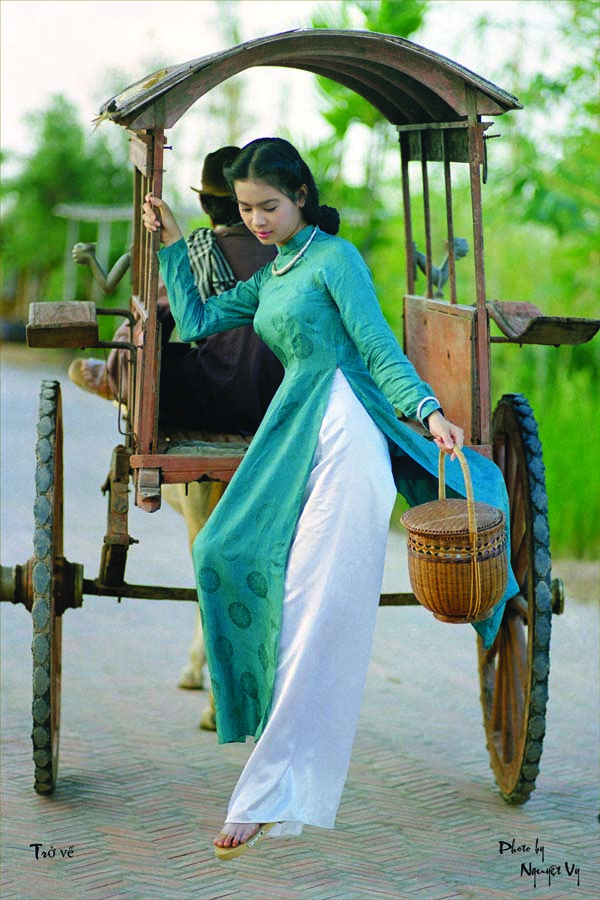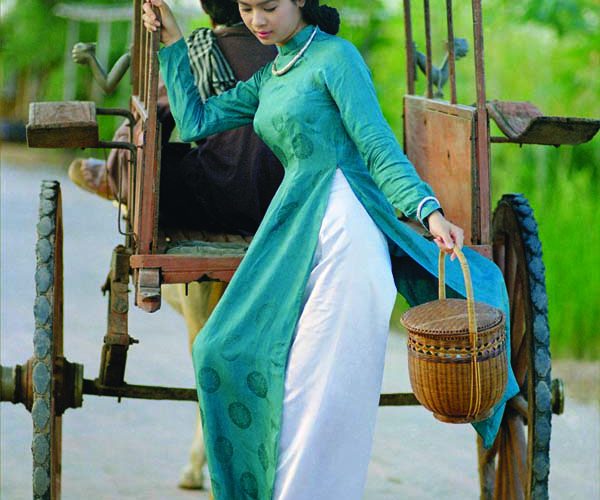(No.2, Vol.8,Apr-May Vietnam Heritage Magazine)

Tr? v?
Home Coming
Author: Nguyet Vy

The feelings brought by Nguyet Vy’s photographs are so strange. One finds oneself deeply moved by something overwhelmingly familiar, simple and pure. It’s not just the soft female form in the old style long dress and the modest but elegant hairdo, but some internal fire lit by memories and spiritual strength typical to Vietnamese women, which is almost forgotten.
On the way looking for her own self, photographer Nguyet Vy found what she thinks is the most durable, most impermanent form of happiness, which is to relive what was the best in each person – the Vietnamese kind of beauty!
There was a picture that first appeared at the Vietnamese Embassy in Sweden, one that was selected to be given to a French President and which was copied and displayed by many souvenir shops on Dong Khoi Street as a symbol of Vietnamese beauty. It was the picture of a young girl in green ao dai getting out of a horse cart, a painting that she titled ‘Home Coming’.
‘Home Coming’ was a kind of manifesto. It means rediscovering Vietnamese aesthetic and spiritual values, coming back to something invisible but clearly present in the trees, the grass, on the pond water, in the deep wells and on moss covered roofs, back to the village of kids with crystal-like eyes and women with dried breasts that have squeezed out the last drop of milk for their child. ‘Home Coming’ is a journey, a dream, a joy that knows no boundaries
‘Home Coming’ was taken in a late afternoon but has taken such a voyage around the world that even its creator couldn’t imagine. First appearing in Nguyet Vy’s photo exhibition entitled ‘Spring Fragrance’ at Vasa Museum in Stockholm, Sweden on the Vietnamese Culture Day in Sweden in 2000, ‘Home Coming’ has travelled all five continents, leaving prints even in Vietnamese restaurants in America and famous resorts and spas, touching so many hearts.
An overseas Vietnamese lady burst into tears at the sight of Nguyet Vy’s ‘Home Coming’ in a resort in Phan Thiet. She said, ‘It reminds me of my maiden time in Saigon and horse carts that transported me in my childhood.’ The photograph brought Nguyet Vy not only fame, but also quite a lot of money, something that rarely happens to photographers.
Beside the sweet, nostalgic beauty there is another photo that portrays the brutal heat of mundane life. Wandering one afternoon in the highlands, her lens by chance caught an ethnic minority family returning from a hard day’s work. Four persons, four silhouettes of pain, look like four slashes on blistered sky. Long sugar canes seem to cut the frame into two, multiplying the sufferings of a human life. A foreign photographer, seeing this work of hers, exclaimed with emotions, ‘This is it, the Vietnam of my heart!’
Nguyet Vy especially loves forests and their Peter Pans and Tinkerbells. She has carried this love since her childhood, because in a sense she was born in a forest and always wants it to be her studio. Only there her wild and mythical nature is completely free. She loves Binh Chau primeval forest, with its incredibly rich flora, with lush green grassy carpets scattered with flowers all year round, with pristine cool creeks hidden under the majestic canopy. So many newlywed couples have made their once-in-a-lifetime album, romantic and full of love, in this forest.
Famous as a nature wedding photographer, she is also notorious as a model ‘torturer’. To take first rays of sunrise, her whole team may have to hit the road at 1 a.m. Everything from clothing to makeup, and lighting . . . has to be prepared, professionally, like in a film crew. It was the film director mindset that helped her get very cinematographic frames.
Once, too absorbed with work, she was stung repeatedly on the head by bees. And her crew never forgets, after hours of selfless work, the time she collected succulent fireweed and caught fish in the creek to make them a meal. Their hearts softened seeing her true, real forest fairy nature, serene but no stranger to sly tricks.
Running away from the glossy light of new studios that sprung up like mushrooms, she came back to the natural light, to sea breezes, to the unpolished nature. She prefers to find her own light and her own angle from which she can unveil a gem inside a rock, giving birth to a photo.
She can’t live without the sun, the breezes, or the forests. She can’t live without her friends, either. For five years, following her husband settling in France, she missed home so much. Nguyet Vy and her husband intend to come back to Vietnam after he retires to enjoy the ‘radiant years of Saigon’ that she loved so much as a maiden.
The ‘Home Coming’ photo series also has Old font and Dusting. It’s a complete trilogy about the spiritual perfection she seeks, the primeval beauty that is wild and taming, boiling and calming.
Now one of the very few artists who succeeded in expressing the inherent beauty of Vietnamese women, having established her ‘own school’ of photography, can you tell me what brought you to the art of photography?
It’s like destiny to me. As a child, I was always mesmerized by the long light cast on the black dress my mother wore to church. The pure light, transparent in the morning and golden in the evening, that transformed my mom’s long black dress into something divine, followed me for years but I never had a chance to express it.
In the darkest and most dire hour of my life, fortunately, fate and God’s grace gave me the miracle of photography. I took it humbly, and little by little, learned how to drive the natural light to shine on children’s innocent hearts, on young girls’ prettiness, on women in ancient outfits that I have rediscovered and restored by myself.
I respect the pristine beauty of the ao dai and find them alluring, mythical, simple and poetic. Every minute of every day, my obsession gradually became passion, an invisible force that swept me into endless adventures to explore the feminine beauty. To me there is nothing as fulfilling as watching how admiringly people react when seeing the ancient mien of the original Vietnamese soul in the faces of the era of IT big bang that I captured.
After so many years, why are you still so passionate about rediscovering the beauty of Vietnamese women in the old ao dai?
In fact, the deeper I push myself, the more I discover the primeval beauty of Vietnamese women in their modern appearance. The qualities thought to have been diminished by time are still there, deep down inside. And when the women put on those dresses, those qualities wake up, ooze out and lighten up like artesian water, pure and profound, solemn and proud.
Those quadruple flaps, those flossy brassière that are both discreet and seductive, I love these half-hidden features so much I can get drunk just thinking about them. I guide my thoughts into each character, in different spaces, under different outfits, to reveal something completely new. Thus my days go by, full of surprises and inspiration. To my utmost pleasure, my models also love the magic. They transfuse their feelings to me. The inspiration, passion, and joy are all mutual and shared.
Following your husband to France, having the means to travel the world and being so well received, you found out that more than anybody else, the overseas Vietnamese long for the beauty gone by?
I had no idea that the people abroad are so passionate about the traditional dresses. They all want to appear in a photo in a dress of the old times with a hairdo and headwear of the old times. Amazingly, those outfits and hair styles look good everywhere, in any setting. Not only do they fit beside a water well with a coconut shell dipper by a thatch roof house, but also against modern cruise ships such as the ‘Freedom of the Seas’ or the ‘Mariner of the Seas’.
I can never forget the image of Ms Minh Tam, Dr Tran Dong A’s wife and other ladies, so classy and elegant in traditional Vietnamese dresses, so surreal on a luxury cruise ship. All others on the ship turned their heads and showed their admiration. And really, was it a contrast or an accord? What could be more traditional than the sky and the sea, and what could be more modern than a beautiful dress? I was so overwhelmingly thrilled to see that not only is the Vietnamese ao dai the queen in a purely Vietnamese setting, but it can also shine and reign in a modern and foreign environment.
The Vietnamese ao dai followed me to New York, Hawaii, to conquer the natural settings of America. Vietnamese and Americans alike, everybody showed their adoration for them at first sight. Once while I was working on a set with a friend of mine, an American couple came over and asked me to take a picture of them in Vietnamese dress. I refused, but the next day I met them again at Saigon Seafoods Restaurant. They knew I was close with the shop owner and came to ask them to put a word for them. I was moved by their heartiness and agreed. It turned out that Americans do look very good in Vietnamese traditional outfits.
You have travelled the world, taken photographs of Queen Silvia of Sweden, and of the stone church, dubbed the ‘swallow’s nest’ of America. Which place has impressed you the deepest?
The more I travel, the more strongly I am drawn back to the poor rural sites of our country. After long trips to America, I always feel I have missed so much the eyes of the kids in the highlands. And so, the first thing I do after landing at home is always to leave everything behind and be a ‘lone wanderer’ and roam from Yen Bai, Ha Giang to Sapa with my camera.
At night, I sleep in a stilted house with the locals, and at first light, I take my camera and go from village to village. It’s there that I found the human warmth, fresh air and deep meaning of ordinary scenes such as a lush green rice field shining brightly under the sun. I enjoy country food, home-grown vegetables and conversations with village elders by the fire place. It all seems to breathe a new life into me. I feel renewed, rejuvenated, more enthusiastic and more tolerant.
Handing new note books to wet-nosed girls, or seeing the sparkling eyes of a little boy receiving a new coat, I realize that the poor and ragged rural countryside is the source of my life and of all of my creations. Each such trip has a reviving effect on me.
What do you think is the most precious in Vietnamese woman’s beauty?
I just want to say to them that it should be the woman’s soul. Without the Vietnamese character and Vietnamese culture, we lose the inner beauty and the lively spirit granted by heaven and given by our parents.
Thank you, and keep on the good work of the ‘keeper of the soul’.

